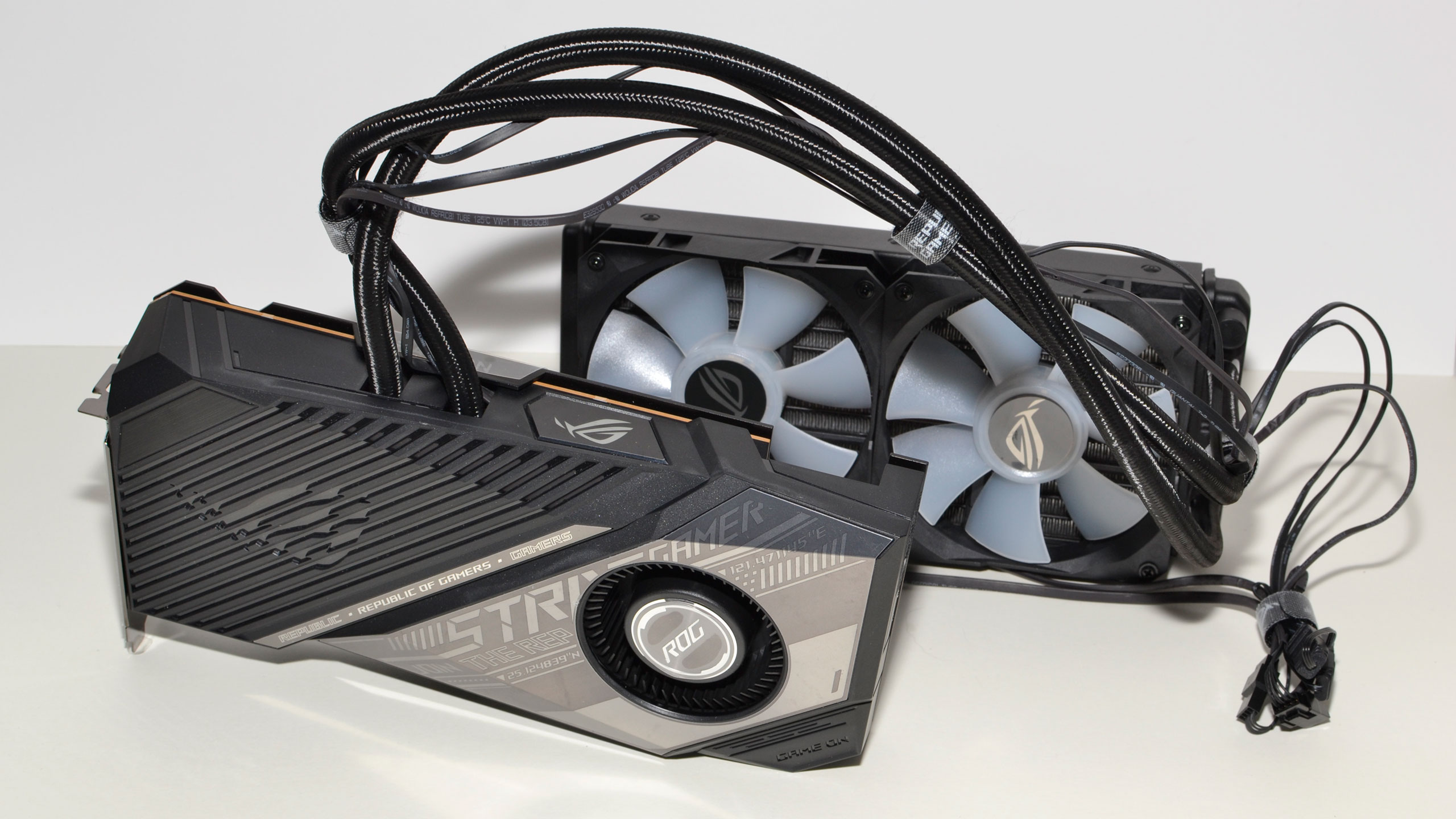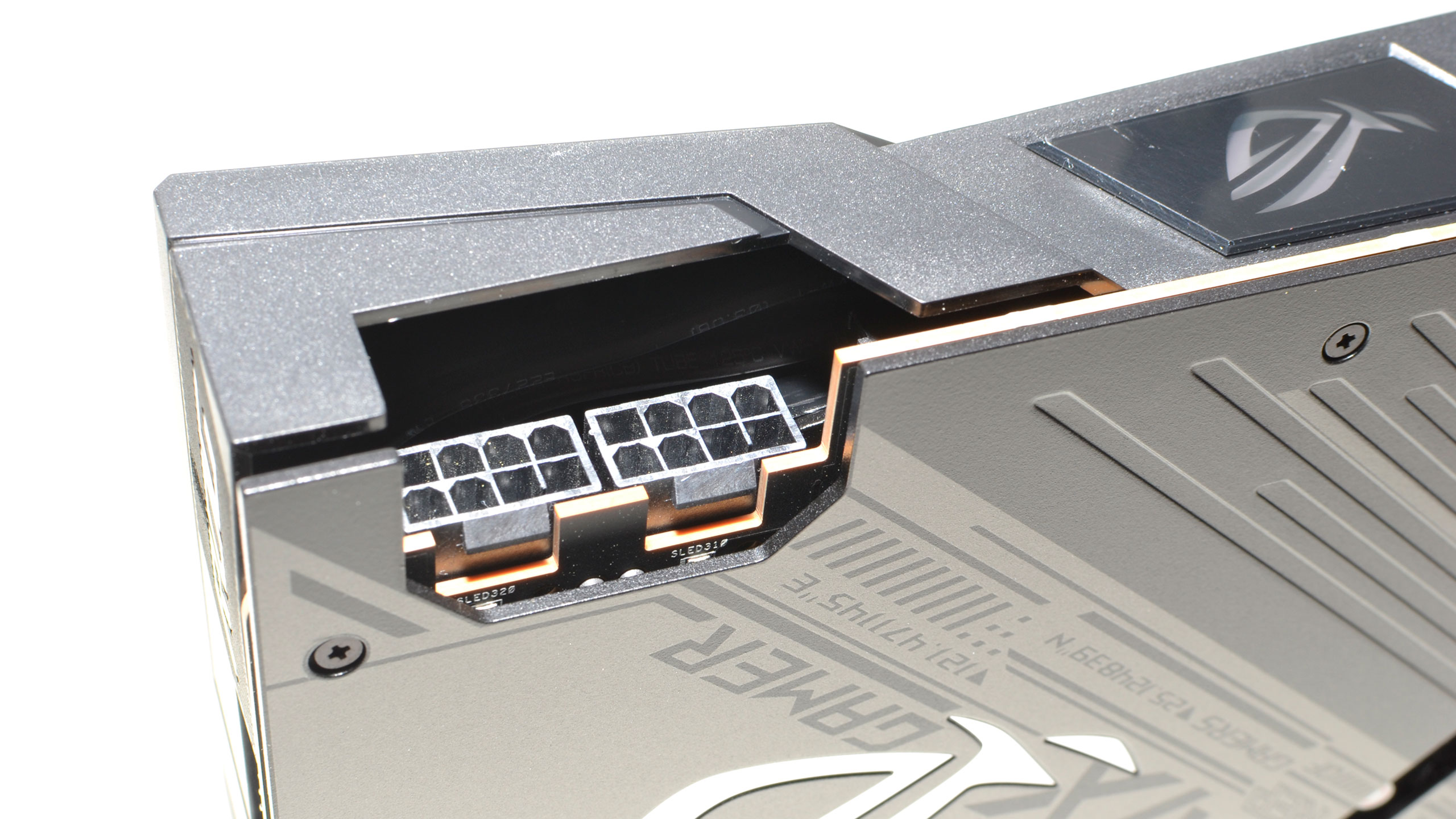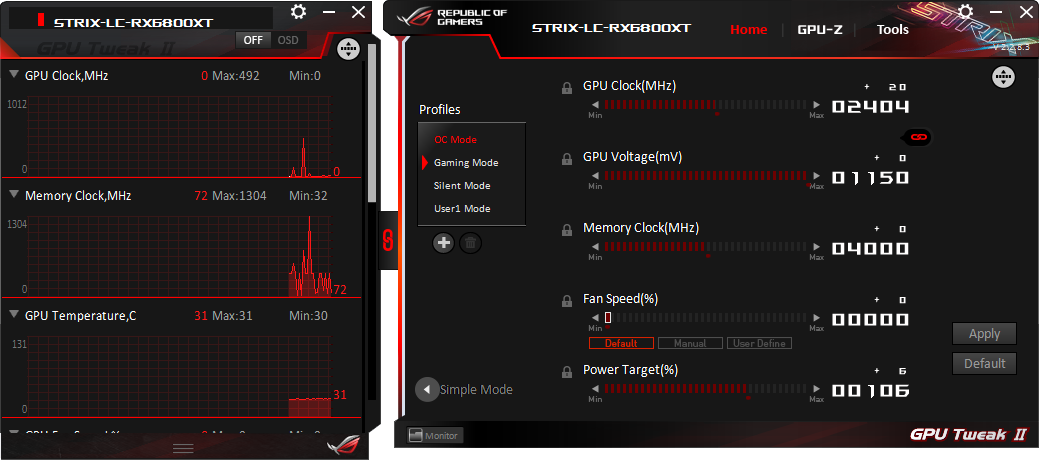AMD Radeon RX 6800 XT Roundup: ASRock, Asus, and Sapphire Reviewed
Factory overclocked RX 6800 XT cards that you still can't find in stock
Pros:
+ Excellent thermals
+ Lots of RGB
+ Great if you want an AIO
Cons:
- Higher price thanks to the AIO
- Requires 240mm radiator mount
- Negligible performance increase
Asus has traditionally stayed away from the AIO graphics card market, but that changes with the ROG Strix LC. Not only does it come with an AIO (all-in-one) liquid cooler, but it includes a relatively large 240mm radiator. Some people will love that option, but it comes at a higher price and can be cumbersome to install — for someone like me that swaps GPUs regularly, AIO cards are more trouble than they're worth.
The external radiator adds a lot of bulk to the package, with the card plus radiator weighing in at 2166g. That's about as much as the RTX 3090 Founders Edition, but the good news is the x16 motherboard slot only has to deal with a 1340g card, with the rest of the bulk secured to the PC chassis. Thanks to the large radiator, the Strix LC can also get by with a traditional 2-slot thickness and a single blower fan on the main card, and the blower doesn't really have to work that hard.

The main graphics card measures 277x131x43.6mm, but the radiator is an additional 276x120x51.7mm. Make sure your case has a good mounting location before taking the plunge. If you're also using a 240mm or larger AIO for CPU cooling, speaking from experience, you'll definitely want to verify both coolers will fit properly before buying.












The ROG Strix line is known for being Asus's top offering, and the Strix LC takes that one step further. Besides the RGB lighting on the graphics card, the two radiator fans also have RGB lighting. The above photos don't really show the RGB properly, but if you have a reasonably dark room and the radiator mounted in a case, there's plenty of RGB to go around. As with many other graphics cards, however, the RGB on the front of the card will end up facing the bottom of your PC in most builds, which sort of defeats the purpose.
Asus lists a relatively tame PSU requirement of 750W, which is technically sufficient based on our testing, but we recommend at least 850W. Actually, with most of the high-end graphics cards, you can make a legitimate argument for 1000W power supplies. PSUs often hit peak efficiency with a load of around 50 percent, and in a high-end PC build, that means the entire PC will consume close to 500W (depending on CPU and other factors) while gaming. If you do plan on using a lower wattage PSU, make sure it's a high-quality offering because the Asus card can hit power draws of over 400W when overclocked.
The big selling point with the Strix LC is, of course, the liquid cooling, and what that does for thermals. Despite having a similar power use and clock speed relative to the other two cards, thermals are far lower even with a modest fan speed. At stock, the Asus card has an excellent temperature of just 53C in FurMark, and that didn't change with our overclocked settings (though fan speeds did have to go up). Temps and fan speeds are even better when playing games, which are generally not as demanding as FurMark when it comes to power. Overall, the Asus card runs 15-20C cooler than the other two custom cards, with the same level of performance, and it delivers a bit more headroom for overclocking.



Speaking of overclocking, you can use Asus's GPU Tweak II (and GPU Tweak III) software suite in addition to the built-in Radeon Software options. By default, like many of Asus's graphics cards, the 6800 XT ROG Strix LC will run at 'gaming' clocks, and you need to install GPU Tweak II and select the OC profile to unlock the full potential. We did this for our testing, though the difference between 'gaming' and 'OC' modes is pretty minimal.
Get Tom's Hardware's best news and in-depth reviews, straight to your inbox.
Is the Strix LC worth the price, though? Originally released with a $900 MSRP, Asus is one of several companies that has recently increased prices due to US tariffs and other factors. The Strix LC 6800 XT now shows a price of $1,080 at the Asus store, and it's still out of stock. It's hard to recommend spending that much money on a GPU that has a nominal price of $650, but then again, that nominal price is nowhere to be found. Maybe we'll eventually see RX 6800 XT cards selling at $700 or less, but for now, they're more commonly in the $1,000+ range. By the time supply improves, we might have other GPUs that represent a better overall value.
MORE: Best Graphics Cards
MORE: Desktop GPU Performance Hierarchy Table
MORE: All Graphics Content
Current page: Asus ROG Strix LC RX 6800 XT Review
Prev Page ASRock Taichi RX 6800 XT Review Next Page Sapphire Nitro+ RX 6800 XT Review
Jarred Walton is a senior editor at Tom's Hardware focusing on everything GPU. He has been working as a tech journalist since 2004, writing for AnandTech, Maximum PC, and PC Gamer. From the first S3 Virge '3D decelerators' to today's GPUs, Jarred keeps up with all the latest graphics trends and is the one to ask about game performance.
-
Makaveli Canadian pricing for these cards. Asrock from newegg.ca and the last two from canada computers.Reply
ASRock Radeon RX 6800 XT Taichi Gaming $1499
SAPPHIRE NITRO+ Radeon RX 6800 XT $1149
ASUS ROG STRIX LC Radeon RX 6800 XT $1299
And for the money Asus is asking for this card, they could have alteast sleeved those fan cables its mess. For $1000+ asking price kinda of a slap in the face. -
Jobeker Your testing methodology is flawed.Reply
The memory should not be overclocked in these cards.
These cards show much better results once you push the GPU to the max & leave the memory at stock.
It seems that you & all the other testers I have come to respect in almost 2 decades of reading tests & benchmarks , have become fixated on maxing the mem to the point of "no crush" without even comparing the results.
I hope you still have at least one of the cards at hand to make 1 more test, you will see that stock mem@2000mhz + GPU@2600mhz gets much better results than mem@2140mhz + GPU@2600mhz .
I am active on a different language forum & a local system builder/fine tuner corroborated these results with several different 6800XT cards.
( he is the one that Identified this issue , I don't own such a card at the moment)
He is now testing a 6900XT .
As a bonus , once you leave the memory at stock you get a few extra watts for higher gpu oc.
I don't care that much about the actual value of the specific cards ( definitely not at current pricing ) it is however very important for me to make sure you testing methodology isn't flawed.
I seriously hope you still have one of the cards for one more test . -
JarredWaltonGPU Reply
Define "much better results" for me, please. The overclocking is not supposed to be the major focus, because silicon lottery and other elements come into play. Frankly, I wouldn't bother overclocking most GPUs -- it's just not enough of a gain to warrant the added power and potential stress on the hardware. Anyway, a 7.5% memory OC isn't much, and neither is the 3-7% increase in performance I measured with the 'max' OC I achieved.Jobeker said:Your testing methodology is flawed.
The memory should not be overclocked in these cards.
These cards show much better results once you push the GPU to the max & leave the memory at stock.
It seems that you & all the other testers I have come to respect in almost 2 decades of reading tests & benchmarks , have become fixated on maxing the mem to the point of "no crush" without even comparing the results.
I hope you still have at least one of the cards at hand to make 1 more test, you will see that stock mem@2000mhz + GPU@2600mhz gets much better results than mem@2140mhz + GPU@2600mhz .
I am active on a different language forum & a local system builder/fine tuner corroborated these results with several different 6800XT cards.
( he is the one that Identified this issue , I don't own such a card at the moment)
He is now testing a 6900XT .
As a bonus , once you leave the memory at stock you get a few extra watts for higher gpu oc.
I don't care that much about the actual value of the specific cards ( definitely not at current pricing ) it is however very important for me to make sure you testing methodology isn't flawed.
I seriously hope you still have one of the cards for one more test .
Dropping the memory OC and trying for a slightly higher core OC is totally within the parameters of what can be done, and may improve performance more than what I've shown. More effort on tuning voltages, fan speeds, etc. could also improve performance. Without physically modding the cards, though, I strongly doubt you'll see more than a 5% improvement over what I achieved, which is a 10% potential total improvement. In practice, I'm sure it would be far less than that -- probably only a 1-2% difference from my max core + max RAM OC results. And there's a very good chance that, despite what you're positing, overclocking the memory actually does improve performance.
Let me give you just one example, because based on this I see no reason to bother retesting anything more.
SettingAsus Strix LC RX 6800 XT OCAsus Strix LC RX 6800 XT OC StockRAMAsus Strix LC RX 6800 XTMetro Exodus1080p Ultra125.09123.2119.46
1440p Ultra105.43103.6999.77
4k Ultra69.4468.5264.81
So, in at least one game, using the same card in all three cases (the Asus Strix LC), dropping the RAM OC but leaving the GPU at the same 2600 MHz setting reduced performance by 1-2%. So much for my "flawed" methodology. -
shady_021 The only thing I see here is all 6800 XT are equal or slightly ahead of a 6900 XT... so except for the price difference what's the point of having a 6900XT?Reply -
JarredWaltonGPU Reply
The overclocked RX 6800 XT cards match the stock RX 6900 XT. If I overclocked the 6900 XT as well, it comes out a bit ahead again.shady_021 said:The only thing I see here is all 6800 XT are equal or slightly ahead of a 6900 XT... so except for the price difference what's the point of having a 6900XT?
This is something I pointed out in the RX 6900 XT review: it has identical clocks, TDP, and VRAM, so the only difference is 80 CUs instead of 72 CUs. That means at most an 11% advantage for the 6900 XT, but because of VRAM being the same it is usually more like 4-5%. So it's not really worth the extra $350, except none of the 6800 XT cards cost $649, and none of the 6900 XT cards cost $999 -- and in fact, neither of those really exists in any meaningful quantity AFAICT. Tens of thousands of cards worldwide perhaps, but that's a drop in the proverbial bucket. -
Jobeker JarredWaltonGPU , Thank you for taking interest in my comment & performing the relevant tests.Reply
I've ( we actually ) been fed with a lot of information in the past 2 weeks that led me to believe the claim I made .
I apologize that it came out rude.
I trust your findings better .
Thank you. -
HC1Gunner Reply
Question, how is this a round up, when other manufactures like Gigabyte weren't included?Admin said:We've rounded up multiple Radeon RX 6800 XT cards to see how the various models stack up. Higher factory overclocks, liquid cooling hybrids, massive coolers, and increased pricing are the general trend while GPUs continue to be in short supply.
AMD Radeon RX 6800 XT Roundup: ASRock, Asus, and Sapphire Reviewed : Read more
Kind of stupid to do these reviews, when you can't find any of these cards for retail sale. -
pbergonzi Reply
Thank you for your thoughtful testing and article.Admin said:We've rounded up multiple Radeon RX 6800 XT cards to see how the various models stack up. Higher factory overclocks, liquid cooling hybrids, massive coolers, and increased pricing are the general trend while GPUs continue to be in short supply.
AMD Radeon RX 6800 XT Roundup: ASRock, Asus, and Sapphire Reviewed : Read more -
JarredWaltonGPU Reply
A roundup isn't every card or manufacturer possible; it's a roundup of the cards we were sent. So rather than three individual 6800 XT reviews, you get a roundup of three cards plus the reference model.HC1Gunner said:Question, how is this a round up, when other manufactures like Gigabyte weren't included?
Kind of stupid to do these reviews, when you can't find any of these cards for retail sale.